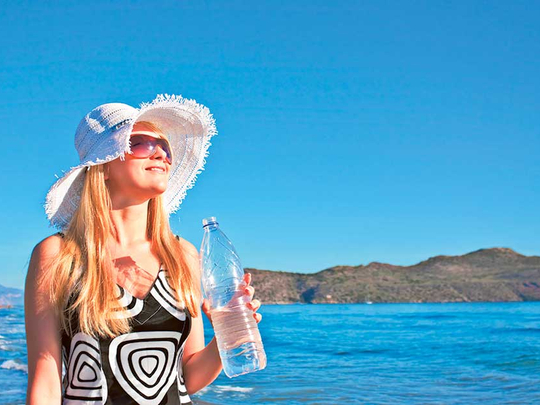
London: The US skincare market is expected to reach $11 billion (Dh40 billion) by 2018, proving that people are more than willing to pay to keep their skin healthy and looking youthful. But expert advice on how to maintain good skin hasn’t changed much over the years.
The bottom line remains: wear sunscreen. Apply it liberally and wear a hat for insurance. Maybe just try to stay in the shade if you can.
But what if, instead of coating yourself in a cream that blocks the sun, you could protect yourself from the inside out? That is the purpose of UVO, a drinkable sunblock developed by Bobby Awadalla, a dermatologist.
“I would see patients every day [who] had long- and short-term effects of sun damage,” Awadalla says. “And despite the consequences, they were hesitant to use sunscreen.”
Research indicates that people are not very consistent when it comes to applying anything topically. Researchers from the US Centres for Disease Control and Prevention (CDC) found that only about 14 per cent of men and 30 per cent of women report regularly using sunscreen on both their faces and bodies.
What’s more, says Raja Sivamani, assistant professor of clinical dermatology at the University of California Davis, the average person who uses sunscreen applies only a fraction of what is needed to protect their skin: one-fourth to one-half the recommended amount sunscreen.
So Awadalla developed what is basically a vitamin cocktail in liquid or powder form that he says protects a person from sun damage for three to five hours, depending on the individual’s skin tone and ability to absorb the vitamins.
The drink, which comes in an orange-peach flavour, can be purchased in a small number of locations in California and Florida as well as on Amazon. While all the ingredients in his drinkable sunscreen are supplements you could find elsewhere, you would have to source the many vitamins individually and take between six to eight capsules in order to get the quantity that Awadalla’s drink provides, he says.
Awadalla has conducted one study, available on his website, that shows the drink protects against sunburn. The sample size was small — 15 subjects — and the dermatologist says he plans to conduct additional research. He also says that he plans on submitting the study to a peer reviewed journal.
While Awadalla says UVO gives users protection from the inside out, he cautions that people should not utilise only one method of sunblock. Like with conventional sunscreen, he recommends using a hat or umbrella, too.
Sivamani, who studies nutritional dermatology, says that more research into drinkable sun protection supplements is needed to learn exactly how they work and what layer of the skin they protect. At the same time, the professor says he would never tell a patient not to add extra sun protection to their existing arsenal if there is science supporting it.
“Studies have shown that eating or drinking certain compounds, including tomato paste and green tea, can give you some protection from burning,” says Jessica Wu, a Los Angeles dermatologist and assistant clinical professor of dermatology at the University of Southern California School of Medicine. UVO contains antioxidants including lycopene, found in tomatoes, and polypodium leucotomos, a fern extract, both of which have some UV protecting effects.”
But when it comes to drinkable sunscreens, they should be seen as “backup protection”, according to Wu. “I think the science is still early and we have to be careful before we talk about replacing tried and true methods,” Sivamani adds.
When it comes to the tried and true, people often forget how important sunscreen is year round. “A daily sunscreen habit is a good habit,” says Sivamani, explaining that incidental exposure, like the kind you get from walking to the train or office in the morning, can add up over time. And that stroll in the sunshine is not the only time you need to be cautious. UVA rays from the sun, which can cause both wrinkles and skin cancer, can pass through window glass, Wu says.
“If it’s a bright day, summer or winter,” she says, “it’s a good idea to use sunscreen whenever you’re outdoors — [or] if you sit [inside] by the window.”
It’s also important to use a sunscreen with “broad spectrum” coverage, like those that contain physical blockers, such as zinc oxide, Sivamani says. A broad spectrum sunscreen will protect against both UVB and UVA rays. While UVB makes the skin burn, UVA can penetrate to the collagen layer and create damage that leads to wrinkles and other skin damage, Sivamani explains. These days there are sunscreens in sun protection factors (SPFs) as high as 100, but after SPF 30 it really does not make a significant difference, Wu says.











